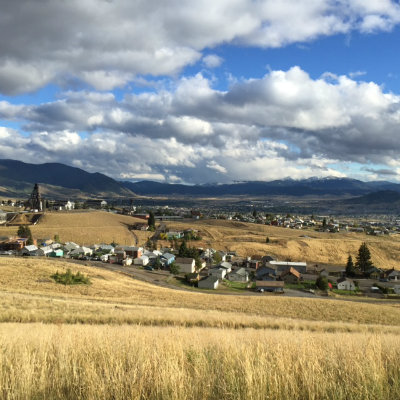 Beautiful vistas surround "The Richest Hill on Earth."
Beautiful vistas surround "The Richest Hill on Earth."Editor’s Note: The Southwest Montana Community Health Center in Butte, Montana, is one of eight primary care community clinics receiving funding through the federal Social Innovation Fund (SIF) initiative to spread the IMPACT program, also known as Collaborative Care, in the rural Northwest.
The John A. Hartford Foundation was one of just four new awardees chosen in 2012 to serve as an intermediary between SIF and subgrantees implementing innovative care models. As a result, a $3 million federal grant has been matched by $3 million from the John A. Hartford Foundation, with additional matching grants from the subgrantees, to spread the IMPACT/Collaborative Care model of depression treatment in Washington, Wyoming, Alaska, Montana, and Idaho.
Set in the heart of the Rocky Mountains and nestled at the base of the Continental Divide, Butte, Montana (or Butte, America as many around here say) is surrounded by both the beauty of the mountains and the battered cityscape of a once bustling copper mining community.
At the turn of the 20th century, Butte thrived as the home of the Copper Kings. People migrated from all over the world to live and work in Butte, drawn by a steady paycheck and a 24-hour rough and tumble town. Best known for its Irish population, Butte also had considerable representation from Wales, Finland, China, the former Yugoslavian nations, and many more.
Boasting a population of more than 100,000 people at its peak, Butte was a lively stop for people traveling from Boston to San Francisco. The city earned a nickname—“The Richest Hill on Earth”—we still use to describe our beloved community.
Today, just over 33,000 people live in Butte, the county seat of Silver Bow County. Times are tough for many in the county, which has the eighth-largest population in Montana, even though it is one of the smallest counties in geographical area. It is estimated that nearly 19 percent of the population lives below the federal poverty line. We struggle with access to care, be it primary or specialty care, mental health care, and addiction services.
 Depression is the most common diagnosis in an area of uncommon beauty.
Depression is the most common diagnosis in an area of uncommon beauty.The Southwest Montana Community Health Center serves nearly one-third of the population of Southwest Montana, drawing from a six-county region and serving anywhere between 14,000 and 16,000 people a year.
A 2014 needs assessment compiled by Silver Bow County’s only hospital ranked mental health and mental disorders as the No. 1 “major problem.” Inadequate resources, access to care, and stigma feed into this problem. Another barrier is that nearly 16 percent of our community has no health insurance and care can be cost-prohibitive. Of the people responding to the needs assessment, a staggering 35 percent of patients reported chronic depression (more than 2 years of symptoms).
The lack of access to care, coupled with the stigma attached to mental health issues in the region, can have deadly consequences: Montana is consistently ranked in the top three states in the nation for highest rate of suicides. Butte-Silver Bow, Beaverhead, and Deer Lodge counties rank among the highest in the state for suicide rate.
The Southwest Montana Community Health Center mirrors our greater community, with depression being the most common diagnosis. We see people on a daily basis who struggle with depression and anxiety, which often exacerbates existing and new physical health conditions. Seeing the effect that mental health and physical health have on each other, we applied for and received a grant to implement the IMPACT collaborative care model of depression treatment through The John A. Hartford Foundation’s Social Innovation Fund initiative. For a little over one year, this grant has allowed us to standardize our process for depression care within our clinic.
The results have been impressive: We regularly see that well over 50 percent of people in our program have reported significant improvement in their overall symptoms, which leads to better health outcomes.
The AIMS Center at the University of Washington has assisted us in understanding the evidence-based model and has provided continued support, including helping us with transitions we have had as a result of staffing changes. With The John A. Hartford Foundation’s support, the AIMS center has provided quality online training, which is critical in frontier Montana, that we never could have accessed or afforded otherwise. AIMS center staff and consultants Diane Powers, Rita Havercamp, and Virna Little have been the key to our success and we are grateful for all of their efforts on our behalf.
What does success look like? We have an 83-year-old man who first presented at the clinic with depression in January 2015. He created a problem list that included being in an unhealthy relationship, financial difficulties, problems with living arrangements, no transportation, religious/values dilemmas, and problems with aging and loneliness.
He entered our IMPACT program, where he engaged in Problem-Solving Therapy—a brief therapy that uses six to 10, 30-minute sessions to help patients solve the “here and now” problems contributing to their depression—and took part in a weekly group. He addressed his transportation issues by getting a car that he is proud of and enjoys caring for. He changed churches to address his religious dilemmas. During the course of treatment, he admitted that he was drinking alcohol daily, and realized that it was negatively affecting his efforts at recovery for his depression. He joined AA and has been in remission since.
He now works in the school district through the Retired Senior Volunteer Program. The most difficult of all of his challenges was ending his unhappy relationship, which he did with the help of the support group he has created since entering the IMPACT program. He is in our relapse prevention program, and still attends weekly group meetings, AA, and church.
It is our belief that this model “impacts” our entire community. The work being done by the patient, primary care provider, counselor, care manager, and staff of the Southwest Montana Community Health Center helps people feel better, which helps them to play more active roles in their families and in our community at-large. This strengthens our community and helps make Butte the “Butte-iful” place that it can be.
This is the sixth in an occasional series of Health AGEnda posts on The John A. Hartford Foundation’s Social Innovation Fund projects. Read the previous posts:
Bringing Proven Depression Treatment to a Greatly Underserved Population
Fighting ‘Chronic Despair’ in Rural Communities in Washington State
For Missoula Clinic, SIF Program Support Is a Dream Come True
Innovative Depression Treatment Helps Sophie Enjoy Better Mental and Physical Health
